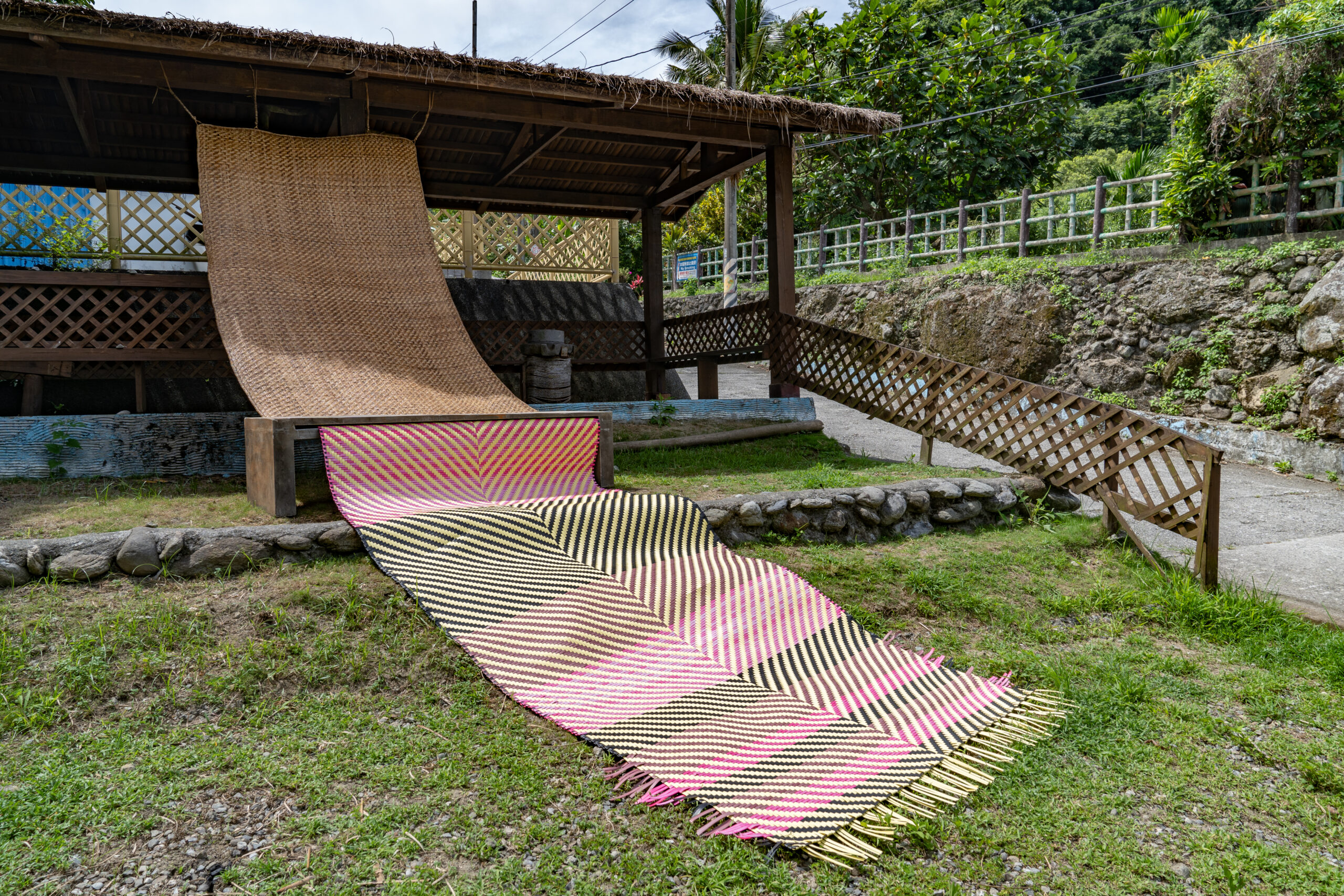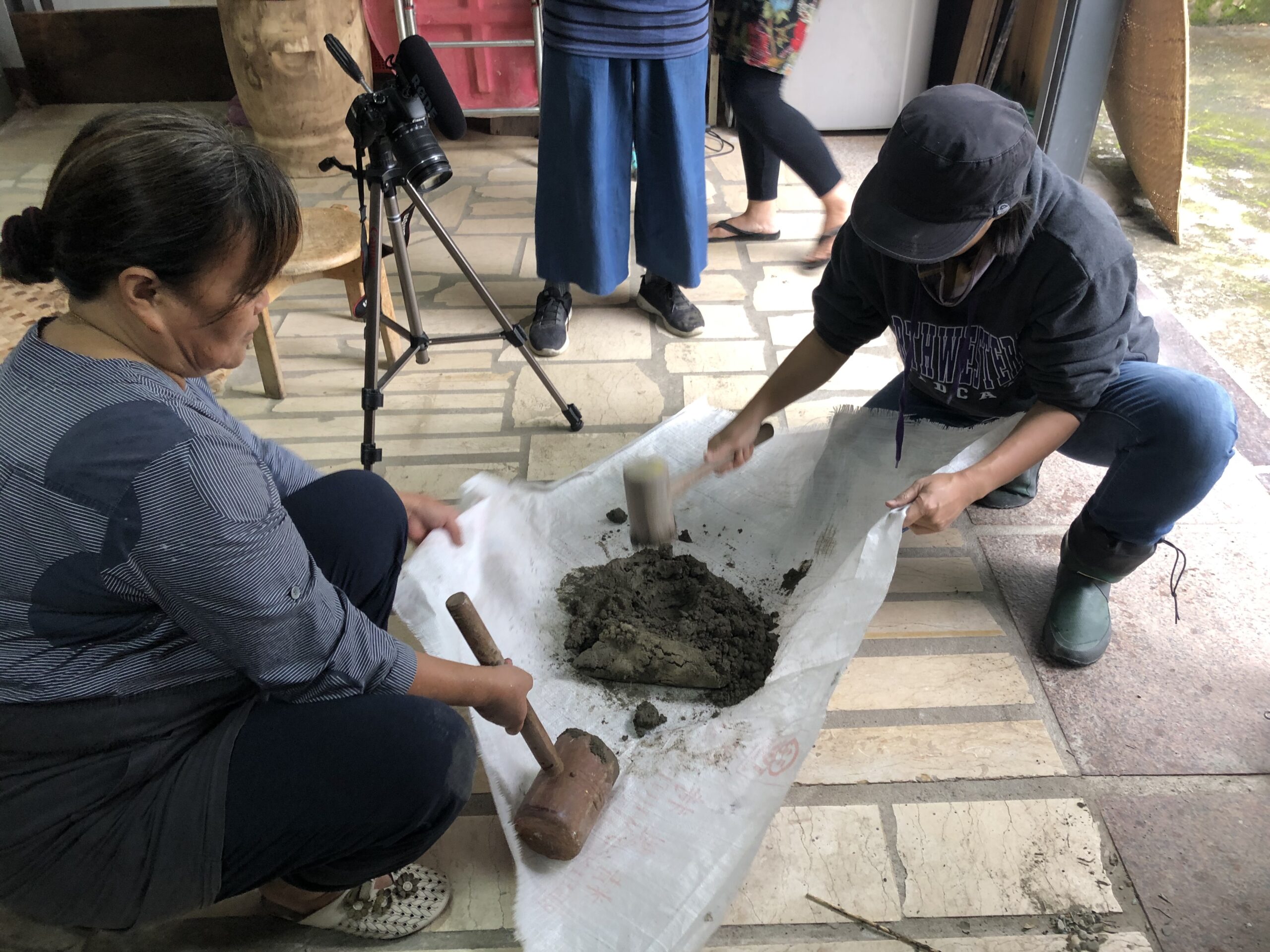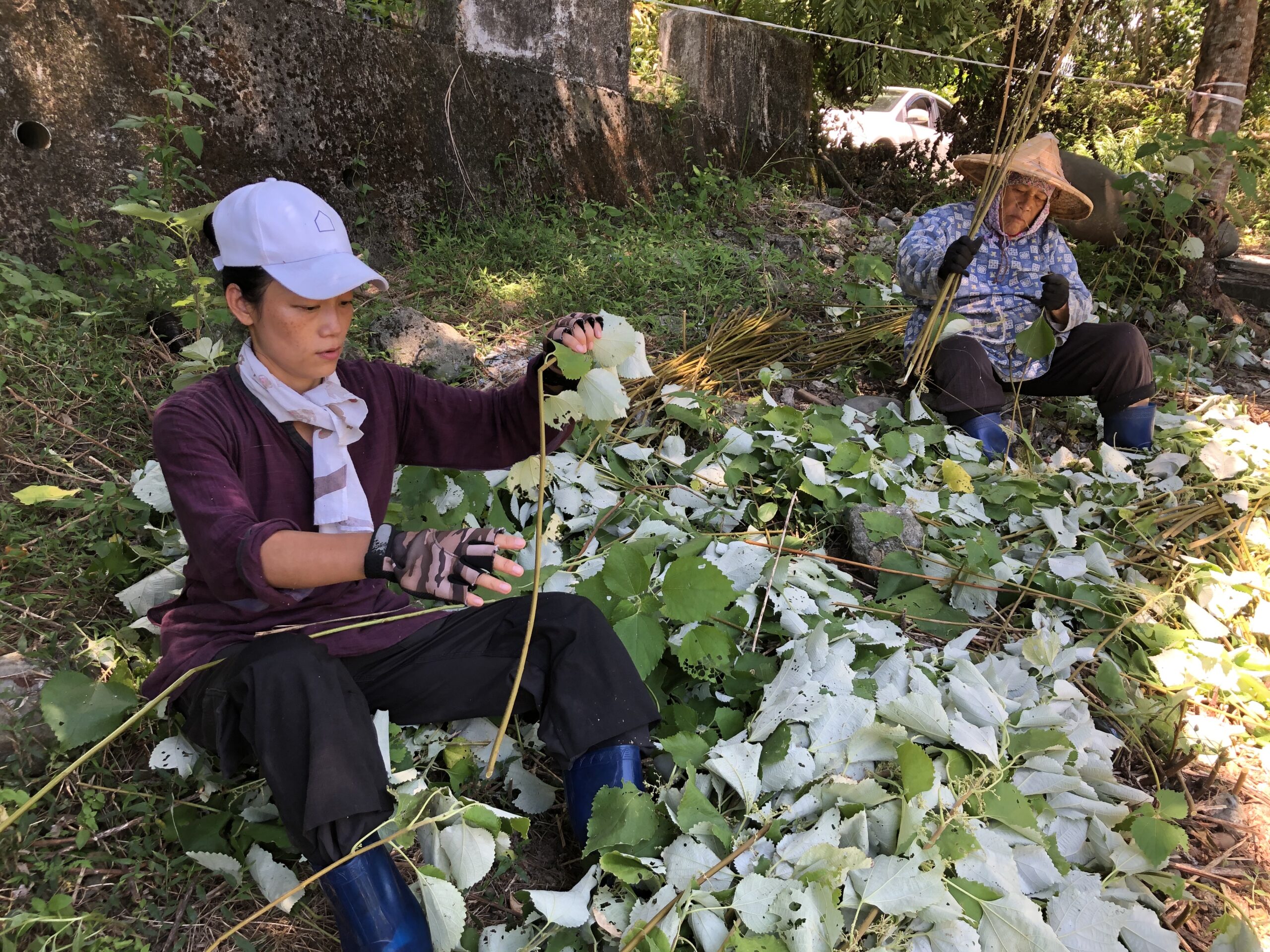2015年,管理範圍由花蓮溪口至小野柳風景特定區,橫跨花蓮、臺東兩縣,海岸線長達168公里的「東部海岸國家風景區」(以下簡稱「東管處」),開辦第一屆「東海岸大地藝術節」。截至目前為止,在花東,此類結合地景藝術、地方觀光、公共參與的藝術季,主要就有四個,還包括以臺東縱谷線197縣道為範圍的「縱谷大地藝術季」、臺東南迴四鄉的「南迴藝術季」,以及花蓮海線的「森川里海濕地藝術季」。衡諸開辦這些藝術季的政策單位,清一色為非藝文專責部門。除了東管處,包括同樣隸屬行政院農業委員會的水土保持局臺東分局,以及林務局花蓮林區管理處。即便如「南迴藝術季」由文化處承辦,預算來源仍為南迴道路拓寬計畫的回饋金。
從這一點來說,與策展團隊、藝術工作者直接產生協商張力的,毋寧為環境治理部門與生態變遷。這篇文章,採訪了近年「東海岸大地藝術節」的策展人李韻儀、「森川里海濕地藝術季」民間主理組織,「節點共創」策展團隊的蘇素敏。她們各自的藝術養成與切入藝術季的脈絡不同,同為移住者,但已分別久居臺東和花蓮,這種長時間的在地性使兩人得以從地方文化生態的肌理與網絡出發,策動藝術季的發生。希望藉此整理,輔以個人的粗淺閱讀,提供大地藝術季的差異觀點,延伸討論。畢竟在今天,從本島到離島,此類藝術季已可說是遍地開花。
 拉黑子.達立夫,《島嶼之影》,2018,海廢尼龍繩、海廢水泥磚、海廢塑膠、鋼筋,400 x 250 x 200 cm、3500 x 250 x 200 cm、300 x 60 x 40 cm x 8,都歷東管處,2018東海岸大地藝術節。圖/東海岸大地藝術節提供
拉黑子.達立夫,《島嶼之影》,2018,海廢尼龍繩、海廢水泥磚、海廢塑膠、鋼筋,400 x 250 x 200 cm、3500 x 250 x 200 cm、300 x 60 x 40 cm x 8,都歷東管處,2018東海岸大地藝術節。圖/東海岸大地藝術節提供
據李韻儀的觀點,藝術節的內在基礎需回到2000年初,從同樣位於東河鄉的都蘭與金樽說起,那是閒置的都蘭糖廠搖身一變為藝文基地的起始,也是「意識部落」在金樽形成的原初;接著下來,公部門主辦的「南島文化節」、「都蘭山藝術節」以及臺11線上的公共藝術設置案,如「海洋印記—東海岸漂流木裝置藝術展」、「加路蘭手創市集」等,都少不了意識部落成員、都蘭藝術家群的身影。漂流木的材料美學與象徵意涵、意識部落的藝術行動與環境美學,以及糖廠咖啡屋作為南來北往的交流門戶,經由這群跨在地的藝術工作者的實踐,陸陸續續形塑了東海岸的藝術特質與文化場域。2002至2004年旅居都蘭的美國音樂家史考特.伊佐(Scott EZELL)便近身觀察:「對意識部落的藝術家而言,漂流木的線條、色澤、紋理之中有種神聖感,那是跨越山與海所表現出的結果,一種無人能理解或複製的巨大輪迴,唯有經由雕刻才能融入其中。」1
李韻儀特別提及,自2006年開始,由藝術家自主提案的「加路蘭手創市集」,市集所在地為加路蘭遊憩區,漂流木的創作、藝術家的手創產品,以及在地音樂人的現場演出,既延續官方與民間的協作關係,此一山海美學的呼喚與複合型態的夏季慶典,亦成為藝術節的雛形;另一方面,東管處自1987年創設以來,工作一直是以環境整理與維護、發展社群關係為主,因為直屬中央,不歸縣政府管轄,它負擔的任務相對單純,對策展團隊來說,即具有相對的自由度。在藝術節開辦前一年,她曾接受委託,研究東海岸的藝術發展,在與公部門來往的過程中,日本的「瀨戶內國際藝術祭」、「越後妻有大地藝術祭」則變成政策背景的重要參照。但李韻儀認為,美學的定調,源自首任策展人潘小雪,自此,「閒暇哲學、觀光凝視、大地美學」奠定了藝術節的核心命題,同時發展出結合駐地創作、地景藝術、開放工作室、手作市集與海洋廚房的整體架構。李韻儀說,都市人來到花東總會帶著「你們好悠閒」的眼光,卻忽略每個人的生存處境,以及花東相對低落的經濟現實,「藝術節在觀光的表象後面,將這個特質浮現出來,讓人沒有辦法藉由日常工作逃避,必須正視自己的內心。」
 伊祐.噶照,2021,《月亮住在海裡》,鋼筋,500 x 200 x 350 cm,加路蘭遊憩區,2021東海岸大地藝術節。圖/東海岸大地藝術節提供
伊祐.噶照,2021,《月亮住在海裡》,鋼筋,500 x 200 x 350 cm,加路蘭遊憩區,2021東海岸大地藝術節。圖/東海岸大地藝術節提供
2017-2018年,李韻儀開始主責「東海岸大地藝術節」的策展工作,主題命名為「潮間共生、島群之間」(2017「潮間共生」,2018「島群之間」)。她後來梳理自身的實踐經驗,將駐地藝術創作、開放工作室及月光海音樂會與市集,視為藝術節的方法,而無論從哪一個面向來看,「與自然同在」皆為貫穿其中的核心。至於藝術節中「大地藝術的創作在對地景的討論,放在自然的公開場合,遠離都市文明的地區,大地藝術作品時常保留了材料被自然力改變,侵蝕的痕跡,保持逐漸變化的生活美感。」2也就是說,相對於必須穩定與可見的公共藝術,「東海岸大地藝術節」的地景藝術則訴諸不穩定與消逝,設置的作品不隨展期結束而拆撤,與環境共存,自有生滅。此外,這也能夠創造一個促進創作交流、維繫相互支援的工班文化的藝術場域。
 左:藝術家歐舟協助參展藝術家菅野麻依子安裝作品《舟》;右:藝術家尼誕.達給伐歷協助參展藝術家以飛魚電銲創作。圖/東海岸大地藝術節提供
左:藝術家歐舟協助參展藝術家菅野麻依子安裝作品《舟》;右:藝術家尼誕.達給伐歷協助參展藝術家以飛魚電銲創作。圖/東海岸大地藝術節提供
「森川里海濕地藝術季」自2011年啟動的「水梯田濕地生態環境裝置藝術展與音樂季」演變而來,中間曾更名為「米粑流濕地藝術季」。米粑流,Mipaliw,即阿美族語的換工、互助之意,最初的主軸為協助豐濱鄉石梯坪水梯田的復育,直到2018年變更為現在的名字。截至目前為止,地理範圍則擴大至海線北段的磯崎、復興以、新社及貓公等部落。藝術季名稱的變更來自林業保育署花蓮分署於2016年推動的地方賦權「森川里海平台」,由「里海」(Satoumi)自「里山」(Satoyama)延伸而來,顧名思義,乃將人類系統與居住環境的共構,向沿海區域擴充,其評估指標包括生態系統、物質循環、活動地域、活動主體、協調共生等基本構面,強調公民社會的協同治理。
現今的主責團隊「節點共創」,便是從2018年的「森川里海」開啟在花東的策展工作。但核心成員蘇素敏、王力之、黃錦城,早已在花東深耕多年。王力之在港口國小旁,將昔日的派出所打造為結合藝術進駐與藝術教育的「cepo’者播藝術中心」,亦為海線上重要的藝文基地。當時,花蓮縣政府的「山海劇場」議題正在延燒,從港口、靜浦到豐濱皆被拒絕後改至磯崎,也是該年藝術季主題「流」所討論的地方自然與人為困境的議題之一。在大多數的藝術節慶活動普遍以刺激觀光作為目標之際,執行團隊卻更在意北川富朗(Fram KITAGAWA)所提出的展覽空檔年,從中開展社區工作。因此,該年藝術季一結束,他們便建議花蓮分署,以兩年為循環,降低部落的耗能,同時讓部落更了解其與藝術季的關係,並以部落社群參與藝術創造動能的「森山里海藝術創生」與藝術季交叉進行。2019年第一屆的藝術創生由部落提出想法,邀請五位表演藝術家進到五個部落,和不同年齡的社群進行駐村工作坊。內部的動能被引發後,延續到隔年的藝術季,藝術家的創作成為地方議題的探究,還是能回到政策資源面談論地方發展,卻更突顯地方參與藝術季的主體性。而時間結構的改變,也讓團隊更能將心力放在調整藝術行動的方法,畢竟部落的複雜度涉及方方面面,盤根錯節,反過來說,藝術季只是一個階段成果的外化呈現。
 陳豪毅(Akac Orat),《蓆地》(Fasulan),2021,打包帶、藤皮、水泥,700 x 180 x 40 cm,2021森山里海濕地藝術季。圖/Night Raven攝影,節點共創提供
陳豪毅(Akac Orat),《蓆地》(Fasulan),2021,打包帶、藤皮、水泥,700 x 180 x 40 cm,2021森山里海濕地藝術季。圖/Night Raven攝影,節點共創提供
一提到創生,很容易與產業掛鉤。但「創生」對團隊而言是「創造」、「創意」、「創新」和「生態」、「生活」、「生產」六個詞彙的集合,是人類為了生存而不斷出現的循環。在「過去的創造即是現在創作(生)的起點」的觀點之下,他們從材料的盤點開始,長時間大量訪談老人家,並邀請藝術家進駐展開材料實驗與文化轉譯,第二年藝術家則會再回到部落,帶著年輕人一起試驗與練習。由材料牽引物質與生活、生態與文化,跳脫了圖鑑式的科學敘述,結合部落的傳說與族人的記憶、技藝的傳承等,使這些材料可感,具有生命力。節點共創參與出版的《臍帶之地:豐濱地方文化材料圖誌vol.1》(2020)即述明願景:「無論是傳統產業的傳承延續、青年返鄉創業、地方觀光事業的創建、新移民落地生根、藝術家駐村、藝術季等相關活動,將可以以這份地圖工具書內容所呈現的軟體基礎,如在地歷史、傳統生活文化種種,做為承接過去進而轉化創造未來的初步憑藉。」當族人發現通過藝術也可以銜接文化傳承的時候,彼此更能相互理解,扎根的工作也就更有著力點。
 《臍帶之地:豐濱地方文化材料圖誌vol.1》一書中收錄的五個部落的材料地圖。圖/王秀茹繪製,節點共創提供
《臍帶之地:豐濱地方文化材料圖誌vol.1》一書中收錄的五個部落的材料地圖。圖/王秀茹繪製,節點共創提供
也就是說,與藝術創生相對關聯的,先是社群,而非地景。回到藝術季的操作,她提到2021年那一屆,邀請參展藝術家到部落學習陶、竹、藤等自然材料,有些藝術家最後做出來的作品,所使用的媒材就與學習到的材料有關,從中可以觀察到每位藝術家看待材料的方式。地景藝術也許會帶來人潮,但那只是附加價值,藝術創生要找到的是「創造」的能力,包含經濟、文化的脈絡,甚至和部落的教育環境、家庭結構到文化傳承的斷裂,環環相扣,無法忽略。
 藝術家吳淑麟向部落婦女學習阿美陶試片、實驗半成品,並帶部落年輕人進行創作。圖/節點共創提供
藝術家吳淑麟向部落婦女學習阿美陶試片、實驗半成品,並帶部落年輕人進行創作。圖/節點共創提供
 藝術家康雅茿與部落族人一起處理苧麻,學習材料實驗,並進行各種纖維材料造形練習。圖/節點共創提供
藝術家康雅茿與部落族人一起處理苧麻,學習材料實驗,並進行各種纖維材料造形練習。圖/節點共創提供
從兩個藝術季的內在因素,到整體的文化政策的影響路徑,乃至與環境治理機制的協商,皆構造著各自的策展方法與美學訴求,與更為複雜、多樣的地方網絡交纏。依據李韻儀歸納的文脈,扣連大地藝術季的生成,其中猶有一條隱藏的政策接徑,即「公共藝術—大地藝術季」的外延效應。倪再沁於著作《台灣公共藝術的探索》中(1997)提及,當時臺灣內部曾針對「Public Art」究竟要翻成「公眾藝術」或者「公共藝術」,有過討論,最後選擇相對遠離原意的後者。如果詞語的翻譯總是影響認知的建構,是否至今仍潛在影響大地藝術季在政策機制、地方治理中,被觀看的方式?
潘小雪接受《藝術觀點ACT》採訪時說過3,九〇年代公共藝術在各地推動時,花蓮即為示範區之一,臺灣大學建築與城鄉研究所提出「使用者有權力設計準則」的觀念,帶動花蓮公共藝術設置的民眾參與。花蓮的藝術工作者也在一場則在「反台泥」社會運動抗爭受挫而生的藝術行動之後,進入當時面臨拆除危機而閒置中的松園別館策辦「漂流木環境裝置藝術展」(2000),同時組成「花蓮縣文化環境創造協會」。隔年,松園別館即受文化建設委員會(現文化部)列為「90年度試辦閒置空間再利用」的六個試辦點之一;都蘭「新東糖廠」黃燦煌經理接受李韻儀訪問時4,也提到最早進駐糖廠的藝術家希巨.蘇飛(2001),因為接下紅葉溫泉裝置藝術案,需要較大的工作空間。而後來「糖廠咖啡屋」(2003)之所以能在糖廠啟動,源於籌備團隊提出「閒置空間再利用」的構想說服他。倘若公共藝術、閒置空間再利用,地景藝術及大地藝術季,(至少在花東)是一組相互連通、前後過渡的詞語系譜,我們又該如何繼續,或回頭述說花東的藝術發展?
 「2023月光.海音樂會」入夜之前演出現場。圖/東海岸大地藝術節提供
「2023月光.海音樂會」入夜之前演出現場。圖/東海岸大地藝術節提供
 藝術家于明珠、邱米溱帶部落婦女進行肢體工作坊並進行演出。圖/節點共創提供
藝術家于明珠、邱米溱帶部落婦女進行肢體工作坊並進行演出。圖/節點共創提供
綜前所述,李韻儀歸納出的「意識部落—都蘭(糖廠)—大地藝術季」前世今生,是以藝術社群啟動;節點共創承接的「水稻田—米耙流—森川里海」藝術季脈流,則自初始的單一部落(港口部落)向多部落放大。進一步說,「社群」與「部落」也是藝術季發動的兩種網絡尺度,但兩者並非涇渭分明,往往相互延異。譬如回溯「水稻田」之前,本世紀的第一個十年,港口部落做為軸心區域,通過創作者的回返、藝術計畫的投入等,已逐漸型塑出一個藝術社群的樣貌。雖然「森川里海」不再聚焦於港口部落,但近年出現的「Makotaay生態藝術村」,復又通過新的策劃軸線與運作方法,一方面銜接既有的藝術社群,同時持續引入外部對話與藝術進駐機制,激發新的動能。
暫離海線,往縱谷望,譬如兒路創作藝術工寮今年的策展命題「GAYA的當代轉生術」,仍據於銅門部落,邀集不同領域、地域、族群的創作者,回應太魯閣族的「Gaya」,可算是以部落為網絡尺度的一例;相對來說,林介文在2021年策展的「裹山 Dungku Asang」,則接近社群的網絡尺度。如果藝術季總是涉及群體,這兩種尺度或可作為我們觀看藝術季在花東的方式,甚至是認識花東當代藝術發展的內在邏輯之一。這樣的群體亦可能會生成不同的「力」,與環境治理、文化生產,形成非典型批判的交換關係。
責任編輯:童詠瑋